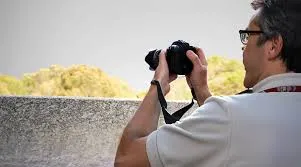Commercial photography is an exciting and rewarding career choice for those who have a passion for photography and a desire to make an impact in the world of advertising, branding, and marketing. Whether you’re capturing product images for eCommerce websites, photographing models for fashion magazines, or creating stunning imagery for real estate listings, commercial photographers play a crucial role in shaping the visual identity of businesses and products.
If you’re looking to break into this lucrative field, this guide will walk you through everything you need to know, from essential skills and education to setting up your business and building a client base. Ready to start your journey to becoming a commercial photographer? Let’s dive in!
What Is Commercial Photography?
Before we delve into the specifics of how to become a commercial photographer, it’s important to understand what this niche entails. Commercial photography is a genre that focuses on creating images for commercial purposes. This includes advertising, marketing, and branding for businesses, organizations, or individuals who need compelling visuals to promote their products or services.
Some common types of commercial photography include:
- Product Photography: Capturing high-quality images of products to be used in advertisements, online stores, and catalogs.
- Fashion Photography: Photographing clothing, accessories, and models for fashion campaigns, magazines, and eCommerce platforms.
- Real Estate Photography: Taking professional photos of homes, buildings, and properties for use in marketing materials and listings.
- Food Photography: Creating mouth-watering images of food for restaurants, cookbooks, or food packaging.
- Lifestyle Photography: Capturing people using products in real-life scenarios, which is often used in advertisements and promotional content.
Why Pursue a Career in Commercial Photography?
There are plenty of reasons why becoming a commercial photographer is an attractive career option:
- Creative Freedom: You’ll have the chance to express your creativity by capturing compelling images that resonate with your clients’ audiences.
- High Earning Potential: Successful commercial photographers often earn a great living, especially if they build a solid client base and work with high-profile brands.
- Flexible Work Environment: Whether you choose to work for an agency, as a freelancer, or start your own photography business, commercial photography offers flexibility in terms of work hours and location.
- Constant Learning and Growth: The world of photography is always evolving, and as a commercial photographer, you’ll have the opportunity to learn new techniques, trends, and technologies.
If these perks appeal to you, then becoming a commercial photographer might be the right path!
1. Understanding the Skills Needed for Commercial Photography
To succeed as a commercial photographer, you’ll need a combination of technical, creative, and business skills. Let’s break these down.
Technical Skills
As with any form of photography, having a solid understanding of camera gear, lighting, and editing software is essential for a commercial photographer. Here’s a breakdown of the technical aspects you should focus on:
- Camera Proficiency: Understanding your camera’s settings (aperture, shutter speed, ISO) is fundamental. You’ll need to know how to use a DSLR or mirrorless camera to capture sharp, high-quality images.
- Lighting: Commercial photography often requires advanced lighting setups. Whether you’re using natural light or artificial lighting, you’ll need to understand how to manipulate light sources to create the desired mood or effect. Learning about light modifiers, softboxes, strobes, and reflectors is a must.
- Post-Processing: Mastering software like Adobe Lightroom and Photoshop is crucial. Most commercial photos need some level of editing, whether it’s color correction, retouching, or compositing images. High-end commercial work requires a great deal of post-production, so learning these tools inside and out will be beneficial. Adphics is one of the experts on this field.
Creative Skills
Technical know-how is essential, but creativity is what will set you apart as a commercial photographer. Here’s what you’ll need to focus on:
- Composition: Learning how to compose your shots effectively is key. The rule of thirds, leading lines, symmetry, and framing are all essential techniques to master.
- Storytelling: Commercial photography isn’t just about taking pretty pictures; it’s about conveying a message or story. Whether you’re photographing a product or a model, you need to understand how to evoke emotions and communicate the brand’s message through your images.
- Attention to Detail: In commercial photography, every little detail matters. From the styling of products to the placement of props and the positioning of your subject, attention to detail is paramount.
Business Skills
In addition to technical and creative skills, you’ll also need strong business acumen. Commercial photography is, after all, a business. Here are a few areas to focus on:
- Client Management: You need to be able to communicate effectively with clients, understand their needs, and manage expectations. This includes negotiating contracts, delivering on deadlines, and maintaining professional relationships.
- Marketing and Branding: Building a personal brand and marketing your photography services is essential to attracting clients. This includes having an up-to-date website, an active social media presence, and a strong portfolio.
- Time Management: Commercial photography projects can be demanding, often involving multiple shoots, tight deadlines, and long hours. Developing strong organizational skills and time management strategies will help you juggle multiple clients and projects effectively.
2. Education and Training: What Do You Need?
One of the most common questions aspiring photographers ask is whether they need formal education to become a commercial photographer. The short answer is: it’s not necessary, but it can certainly help.
Formal Education vs. Self-Taught
Some commercial photographers attend photography schools or universities, earning degrees or certifications. This formal education provides a structured approach to learning photography, with access to experienced instructors and mentors. However, many successful commercial photographers are self-taught, learning through practice, online tutorials, books, and hands-on experience.
Building a Portfolio
One of the most critical aspects of breaking into commercial photography is building a strong portfolio. Your portfolio showcases your style, technical ability, and versatility to potential clients. Include a diverse range of work that demonstrates your skill in different areas of commercial photography, such as product shots, portraits, and lifestyle images.
Mentorship and Apprenticeships
In addition to formal education and self-study, consider seeking out mentorship or internships. Learning from established photographers can give you valuable insights into the business side of photography, client management, and industry best practices.
3. Setting Up Your Photography Business
If you want to become a successful commercial photographer, you’ll need to set up your own photography business. Here’s what you need to get started:
Creating a Photography Brand
Branding is critical in the competitive world of commercial photography. Your brand should reflect your style, values, and approach to photography. This includes your business name, logo, website design, and tone of voice across marketing materials. Make sure your brand communicates your unique value proposition—why clients should choose you over competitors.
Essential Equipment for Commercial Photography
Investing in the right equipment is crucial. Some basic equipment you’ll need includes:
- Cameras: A high-quality DSLR or mirrorless camera is essential. Some popular options for commercial photographers are the Canon EOS 5D Mark IV or the Sony A7R IV.
- Lenses: Lenses will depend on the type of commercial photography you’re focusing on. For example, a 50mm prime lens is great for portraits, while a 24-70mm zoom lens is ideal for product photography.
- Lighting Gear: Softboxes, ring lights, and strobe lights are commonly used in commercial photography to create perfect lighting conditions.
- Editing Software: Adobe Lightroom and Photoshop are the industry standards for photo editing. These tools will help you fine-tune your images, whether you’re making small adjustments or doing more complex post-processing.
Setting Your Pricing Structure
One of the trickiest parts of running a commercial photography business is setting your rates. Your pricing will depend on several factors, such as your experience level, the type of commercial photography you’re doing, and the size of your client base. Research your local market to understand what other photographers charge and determine a pricing strategy that works for you.
4. Building a Strong Client Base
Once you have the skills, equipment, and business in place, it’s time to start finding clients. Here’s how:
Networking and Building Relationships
Networking is essential in commercial photography. Attend industry events, workshops, and trade shows where you can meet potential clients, such as marketing managers, brand managers, and creative directors.
Social media platforms like Instagram and LinkedIn are also powerful tools for connecting with clients and showcasing your work. Consistently posting high-quality images and engaging with your followers can help you attract clients organically.
Marketing Strategies for Photographers
In addition to networking, you’ll need to develop a strong online presence. A well-designed website is essential for showcasing your portfolio and providing potential clients with information about your services. You can also start a blog to share photography tips, behind-the-scenes stories, and case studies that demonstrate your expertise.
Investing in SEO (search engine optimization) will help your website rank higher in Google search results, making it easier for potential clients to find you. Other marketing strategies include email marketing and paid advertising through platforms like Google Ads or Facebook Ads.
5. How to Manage a Successful Commercial Photography Career
To succeed long-term, you need to keep evolving and adapting to industry trends. Here’s how to stay ahead of the curve:
Staying Up-to-Date with Trends
The world of commercial photography is constantly changing, with new trends, tools, and technologies emerging regularly. To stay relevant and competitive, it’s essential to keep learning and evolving. Here are some ways you can stay updated:
- Follow Industry Blogs and Podcasts: Subscribe to photography blogs, YouTube channels, and podcasts that focus on commercial photography trends, lighting techniques, and gear reviews. Websites like Petapixel, Fstoppers, and Digital Photography Review are great resources for keeping your skills sharp and staying on top of the latest innovations.
- Attend Workshops and Conferences: Participate in workshops or attend photography conferences to learn new techniques and network with other professionals. Events like WPPI (Wedding and Portrait Photographers International) and PhotoPlus Expo can provide excellent learning opportunities and a chance to connect with industry influencers.
- Experiment with New Techniques: Whether it’s experimenting with drone photography, 360-degree images, or video content, don’t be afraid to try new things. Trends like motion content (cinemagraphs, video ads) and augmented reality (AR) photography are becoming more integrated into commercial marketing campaigns.
- Understand Changing Client Needs: Commercial photography is often driven by marketing and branding needs, which evolve over time. Pay attention to changes in consumer preferences, technological advancements, and emerging visual styles. For example, minimalist photography and sustainability in advertising are currently gaining popularity.
Expanding Your Services
To truly stand out as a commercial photographer, consider expanding your service offerings. By diversifying your portfolio, you can attract a wider range of clients and command higher rates. Here are some ways to diversify your services:
- Videography: Many brands are looking for photographers who can also create video content. If you have an interest in motion work, learning videography can be a great way to expand your skill set. Video marketing is growing rapidly, and being able to offer both stills and video could make you more marketable.
- Drone Photography: If you haven’t already, consider learning how to operate a drone for aerial photography. Real estate agents, construction companies, and event planners are all looking for stunning aerial shots, making this a valuable skill to have in your toolkit.
- 360-Degree Photography: This is particularly relevant for industries like real estate, tourism, and retail. Offering 360-degree photography can enhance your portfolio and provide clients with a more immersive experience.
- Styling and Art Direction: Another way to increase your value is to offer styling and art direction services. Commercial photography often requires specific styling for products, models, or even food shoots. If you have a good eye for styling or design, consider taking on these roles as well.
- Stock Photography: While it’s a competitive field, selling your photos on stock photography platforms like Shutterstock, Adobe Stock, or Getty Images can create a passive income stream. If your work aligns with popular commercial photography categories like lifestyle, business, or technology, this could be a great opportunity.
Building a Reputation
A successful career in commercial photography is built not just on skill but also on reputation. How do you get clients to trust you, recommend you, and keep coming back? Here are some strategies to build and maintain a strong reputation:
- Deliver Consistently High-Quality Work: This is non-negotiable. Whether you’re shooting a product for an eCommerce brand or a lifestyle shoot for a fashion magazine, always ensure that your photos are technically perfect and creatively compelling.
- Seek Client Testimonials: After a successful shoot, ask satisfied clients for testimonials or reviews. Positive feedback can help you build credibility and trust with new clients. Display these testimonials prominently on your website and social media profiles.
- Word-of-Mouth Referrals: In the photography industry, word-of-mouth is a powerful marketing tool. Always aim to exceed your client’s expectations, as happy clients are more likely to recommend you to others. Maintain good relationships with your clients, as repeat business and referrals are key to long-term success.
- Publish Your Work in Reputable Publications: Another great way to establish your reputation is by getting your work published in magazines, online blogs, and other high-traffic platforms. Being featured in well-known publications (such as AdWeek, The New York Times, or Vogue) can serve as a strong endorsement of your talent.
- Collaborate with Other Creatives: Building relationships with other creatives—like stylists, models, makeup artists, and designers—can help expand your network and lead to more opportunities. Collaborations allow you to work on interesting and innovative projects that will enrich your portfolio.
6. Overcoming Challenges in Commercial Photography
While a career in commercial photography can be incredibly rewarding, it’s not without its challenges. Let’s take a look at some common obstacles and how to overcome them.
Dealing with Difficult Clients
In commercial photography, you’ll encounter all kinds of clients with different expectations and demands. Some may have a clear vision, while others might be indecisive or overly critical. Here are some strategies for managing client relationships:
- Clear Communication: Always ensure that you understand the client’s needs before the shoot. Ask detailed questions about their expectations, the mood they want to convey, and the type of images they require. This will help avoid misunderstandings later on.
- Set Boundaries: It’s important to set clear expectations from the start, including project timelines, pricing, and what the client will receive. Having a contract in place can help prevent any miscommunications and protect both parties.
- Handle Criticism Professionally: Not every client will love every shot you take, and that’s okay. Learn to handle constructive criticism with grace. Be open to feedback and be willing to make adjustments, but also trust your expertise.
Managing Busy Seasons and Downtime
In commercial photography, there may be times when you’re overwhelmed with work, and other times when business slows down. Here’s how to manage the ups and downs:
- Plan Ahead: During busy periods, it’s easy to get caught up in the rush and miss out on long-term opportunities. Try to plan your schedule ahead of time, ensuring that you’re not overcommitting or underpricing yourself just to fill your calendar.
- Save for Downtime: Just as freelancers and business owners in other industries experience slow periods, commercial photographers also face ebbs and flows. Save a portion of your earnings during busy months to ensure financial stability when business is slower.
- Use Downtime Wisely: Slow periods are a great time to focus on personal projects, updating your portfolio, learning new skills, or working on marketing efforts. You can also use downtime to connect with past clients and check in on potential new leads.
Staying Inspired and Avoiding Burnout
Creative burnout can be a real concern for photographers, especially when you’re working long hours under pressure. Here’s how to keep your creative spark alive:
- Take Breaks: Whether it’s a weekend off or a vacation, taking breaks from work is essential for recharging your energy. Stepping away from the camera allows you to return with a fresh perspective.
- Experiment with Personal Projects: Sometimes, working on personal photography projects can reignite your passion. Experimenting with new techniques, shooting for fun, or exploring new genres can help you stay inspired.
- Find Support from Fellow Creatives: Engaging with other photographers, whether through social media groups or in-person meetups, can help you feel part of a creative community. Sometimes, sharing experiences and challenges with others can help you push through tough times.
Conclusion: Is Commercial Photography Right for You?
Becoming a commercial photographer is a rewarding and fulfilling career, but it requires dedication, skill, and business savvy. By mastering both the technical and creative aspects of photography, building a strong portfolio, and continuously evolving with industry trends, you can carve out a successful niche in this competitive field.
If you’re passionate about photography, have a keen eye for detail, and love working with brands and businesses, then commercial photography might be the perfect fit for you. Keep honing your craft, investing in your equipment and skills, and growing your network—and you’ll be well on your way to success.




